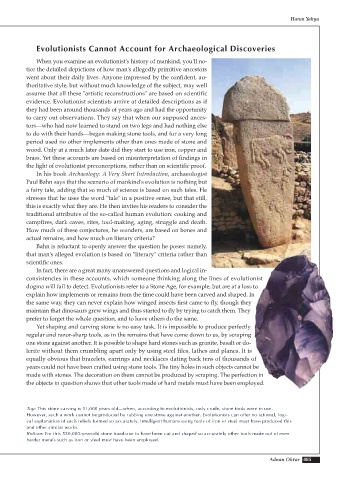Page 487 - Atlas of Creation Volume 2
P. 487
Harun Yahya
Evolutionists Cannot Account for Archaeological Discoveries
When you examine an evolutionist's history of mankind, you'll no-
tice the detailed depictions of how man's allegedly primitive ancestors
went about their daily lives. Anyone impressed by the confident, au-
thoritative style, but without much knowledge of the subject, may well
assume that all these "artistic reconstructions" are based on scientific
evidence. Evolutionist scientists arrive at detailed descriptions as if
they had been around thousands of years ago and had the opportunity
to carry out observations. They say that when our supposed ances-
tors—who had now learned to stand on two legs and had nothing else
to do with their hands—began making stone tools, and for a very long
period used no other implements other than ones made of stone and
wood. Only at a much later date did they start to use iron, copper and
brass. Yet these accounts are based on misinterpretation of findings in
the light of evolutionist preconceptions, rather than on scientific proof.
In his book Archaeology: A Very Short Introduction, archaeologist
Paul Bahn says that the scenario of mankind's evolution is nothing but
a fairy tale, adding that so much of science is based on such tales. He
stresses that he uses the word "tale" in a positive sense, but that still,
this is exactly what they are. He then invites his readers to consider the
traditional attributes of the so-called human evolution: cooking and
campfires, dark caves, rites, tool-making, aging, struggle and death.
How much of these conjectures, he wonders, are based on bones and
actual remains, and how much on literary criteria?
Bahn is reluctant to openly answer the question he poses: namely,
that man's alleged evolution is based on "literary" criteria rather than
scientific ones.
In fact, there are a great many unanswered questions and logical in-
consistencies in these accounts, which someone thinking along the lines of evolutionist
dogma will fail to detect. Evolutionists refer to a Stone Age, for example, but are at a loss to
explain how implements or remains from the time could have been carved and shaped. In
the same way, they can never explain how winged insects first came to fly, though they
maintain that dinosaurs grew wings and thus started to fly by trying to catch them. They
prefer to forget the whole question, and to have others do the same.
Yet shaping and carving stone is no easy task. It is impossible to produce perfectly
regular and razor-sharp tools, as in the remains that have come down to us, by scraping
one stone against another. It is possible to shape hard stones such as granite, basalt or do-
lerite without them crumbling apart only by using steel files, lathes and planes. It is
equally obvious that bracelets, earrings and necklaces dating back tens of thousands of
years could not have been crafted using stone tools. The tiny holes in such objects cannot be
made with stones. The decoration on them cannot be produced by scraping. The perfection in
the objects in question shows that other tools made of hard metals must have been employed.
Top: This stone carving is 11,000 years old—when, according to evolutionists, only crude, stone tools were in use.
However, such a work cannot be produced by rubbing one stone against another. Evolutionists can offer no rational, logi-
cal explanation of such reliefs formed so accurately. Intelligent humans using tools of iron or steel must have produced this
and other similar works.
Bottom: For this 550,000-year-old stone hand-axe to have been cut and shaped so accurately other tools made out of even
harder metals such as iron or steel must have been employed.
Adnan Oktar 485

